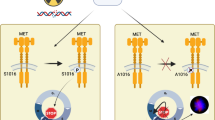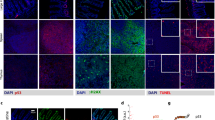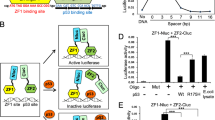Abstract
Induction of the transactivation function of p53 after cellular irradiation was studied under conditions in which upstream signaling events modulating p53 activation were uncoupled from those regulating stabilization. This investigation prompted the discovery of a novel radiation-responsive kinase pathway targeting Ser20 that results in the masking of the DO-1 epitope in undamaged cells. Unmasking of the DO-1 epitope via dephosphorylation occurs in response to low doses of non-ionizing radiation. Our data show that phosphorylation at Ser20 reduces binding of the mdm2 protein, suggesting that a function of the Ser20-kinase pathway may be to produce a stable pool of inactive p53 in undamaged cells which can be readily activated after cellular injury. Phospho-specific monoclonal antibodies were used to determine whether the Ser20 signaling pathway is coupled to the Ser15 and Ser392 radiation-responsive kinase pathways. These results demonstrated that: (1) dephosphorylation at Ser20 is co-ordinated with an increased steady-state phosphorylation at Ser392 after irradiation, without p53 protein stabilization, and (2) stabilization of p53 protein can occur without Ser15 phosphorylation at higher doses of radiation. These data show that the Ser20 and Ser392 phosphorylation sites are both targeted by an integrated network of signaling pathways which is acutely sensitive to radiation injury.
This is a preview of subscription content, access via your institution
Access options
Subscribe to this journal
Receive 50 print issues and online access
$259.00 per year
only $5.18 per issue
Buy this article
- Purchase on Springer Link
- Instant access to full article PDF
Prices may be subject to local taxes which are calculated during checkout







Similar content being viewed by others
References
Berns EM, Klijn JG, van Putten WL, de Witte HH, Look MP, Meijer-van Gelder ME, Willman K, Portengen H, Benraad TJ and Foekens JA. . 1998 J. Clin. Oncol. 16: 121–127.
Blaydes JP, Gire V, Rowson JM and Wynford-Thomas D. . 1997 Oncogene 14: 1859–1868.
Blaydes JP and Hupp TR. . 1998 Oncogene 17: 1045–1052.
Bond J, Webley K, Wyllie F, Jones C, Craig A, Hupp T and Wynford-Thomas D. . (1999) in press Oncogene.
Bottger A, Bottger V, Sparks A, Liu WL, Howard SF and Lane DP. . 1997 Curr. Biol. 7: 860–869.
Bradford MM. . 1976 Anal. Biochem. 72: 248–254.
Cairns CA and White RJ. . 1998 EMBO J. 17: 3112–3123.
Chesnokov I, Chu WM, Botchan MR and Schmid CW. . 1996 Mol. Cell. Biol. 16: 7084–7088.
Dover R, Jayaram Y, Patel K and Chinery R. . 1994 J. Cell Sci. 107: 1181–1184.
Haupt Y, Maya R, Kazaz A and Oren M. . 1997 Nature 387: 296–299.
Hupp TR and Lane DP. . 1994 Cold Spring Harb. Symp. Quant. Biol. 59: 195–206.
Hupp TR and Lane DP. . 1995 J. Biol. Chem 270: 18165–18174.
Hupp TR, Sparks A and Lane DP. . 1995 Cell 83: 237–245.
Kaghad M, et al. 1997 Cell 90: 809–819.
Kastan MB, Onyekwere O, Sidransky D, Vogelstein B and Craig RW. . 1991 Cancer Research 51: 6304–6311.
Kubbutat MHG, Jones SN and Vousden H. . 1997 Nature 387: 299–303.
Kussie PH, Gorina S, Marechal V, Elenbaas B, Moreau J, Levine AJ and Pavletich NP. . 1996 Science 274: 948–953.
Lambert PF, Kashanchi F, Randonovich MF, Shiekhattar R and Brady JN. . 1998 J. Biol. Chem. 273: 33048–33053.
Lu X and Lane DP. . 1993 Cell 75: 765–778.
Lutzker SG and Levine AJ. . 1996 Nature Medicine 2: 804–810.
Midgley CA and Lane DP. . 1997 Oncogene 15: 1179–1189.
Oren M and Prives C. . 1996 Biochim. Biophys. Acta 1288: R13–19.
Pise-Masison CA, Radonovich M, Sakaguchi K, Appella E and Brady JN. . 1998 J. Virol. 72: 6348–6355.
Ravera MW, Carcamo J, Brissette R, Alam-Moghe A, Dedova O, Cheng W, Hsiao KC, Klebanov D, Shen H, Tang P, Blume A and Mandecki W. . 1998 Oncogene 16: 1993–1999.
Sakaguchi K, Sakamoto H, Lewis MS, Anderson CW, Erickson JW, Appella E and Xie D. . 1997 Biochemistry 36: 10117–10124.
Shieh SY, Ikeda M, Taya Y and Prives C. . 1997 Cell 91: 325–334.
Siliciano JD, Canman CE, Sakaguchi K, Apella E and Kastan MB. . 1997 Genes Dev. 11: 3471–3481.
Soussi T and May P. . 1996 J. Mol. Biol. 260: 623–637.
Stephen CW, Helminen P and Lane DP. . 1995 J. Mol. Biol. 248: 58–78.
Thompson AM, Steel CM, Chetty U, Dixon JM and Carter DC. . 1998 Br. J. Surg. 82: 210–211.
Unger T, Juven-Gershon T, Moallem E, Berger M, Vogt Sionov R, Lozano G, Oren M and Haupt Y. . 1999 EMBO J. 18: 1805–1814.
Van der Greer P, Luo K, Sefton BM and Hunter T. . (1993). In: Hardie G. (ed Protein Phosphorylation IRL press: Oxford pp 31–58.
Venkatachalam S, Shi YP, Jones SN, Vogel H, Bradley A, Pinkel D, Donehower LA. . 1998 EMBO J. 17: 4657–4667.
Vojtesek B, Dolezalova H, Lauerova L, Svitakova M, Havlis P, Kovarik J, Midgley CA and Lane DP. . 1995 Oncogene 10: 389–393.
Waterman MJ, Stavridi ES, Waterman JL and Halazonetis TD. . 1998 Nat. Genet. 19: 175–178.
Yeargin J and Haas M. . 1995 Curr. Biol. 5: 423–431.
Acknowledgements
We wish to thank our colleagues for enthusiastic support and encouragement during the course of these studies. Moravian Biotechnologies supported the development of Phospho-specific monoclonal antibodies. AL Craig is the recipient of a Ph.D. studentship from the Medical Research Council. TR Hupp is supported by grants from the Medical Research Council and the Cancer Research Campaign. We wish to thank the charity Breast Cancer Research Scotland for their generous support of cancer research in Dundee.
Author information
Authors and Affiliations
Rights and permissions
About this article
Cite this article
Craig, A., Blaydes, J., Burch, L. et al. Dephosphorylation of p53 at Ser20 after cellular exposure to low levels of non-ionizing radiation. Oncogene 18, 6305–6312 (1999). https://doi.org/10.1038/sj.onc.1203085
Received:
Revised:
Accepted:
Published:
Issue Date:
DOI: https://doi.org/10.1038/sj.onc.1203085
Keywords
This article is cited by
-
Deacetylation of p53 after nerve growth factor treatment in PC12 cells as a post-translational modification mechanism of neurotrophin-induced tumor suppressor activation
Oncogene (2004)
-
p53: Twenty five years understanding the mechanism of genome protection
Journal of Physiology and Biochemistry (2004)
-
The evolution of diverse biological responses to DNA damage: insights from yeast and p53
Nature Cell Biology (2001)
-
Evidence that wild-type p53 in neuroblastoma cells is in a conformation refractory to integration into the transcriptional complex
Oncogene (2001)
-
Unmasking of phosphorylation-sensitive epitopes on p53 and Mdm2 by a simple Western-phosphatase procedure
Oncogene (2000)



